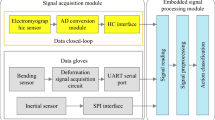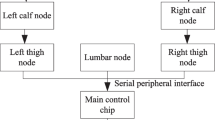Abstract
When remote sports injuries are traditionally monitored, the feedback is not timely, and there are some problems such as low running speed and poor accuracy of sports injury monitoring. Therefore, this paper designs a remote sports injury monitoring method based on a wireless sensor network. Firstly, the terminal node of the sports injury monitoring process is designed, and three-terminal devices are tied to the experimental object's body to collect motion information, to realize the collection of human motion information based on ZigBee wireless sensor network; Secondly, the USB module circuit interface is designed to realize the series connection of each line, and the local processing ability of network nodes is used to make a centralized decision. Then, the skeleton coordinate system is constructed, and the rotation of the human skeleton is measured by an inertial sensor. Through a variety of posture fitting, the error of remote sports injury monitoring is reduced from the two directions of joint error and muscle error. Finally, the training sample set is learned through the BP algorithm, the fitness function of the genetic algorithm is obtained, the external structural parameters of the adaptive neural network model are adjusted, the discrimination deviation and fitness function are calculated, the adaptive neural network model with the best generalization ability is output, and the local processing ability of remote sports injury monitoring method is improved combined with wireless sensor network technology, The design of remote sports injury monitoring method based on wireless sensor network is realized. The experimental results show that the accuracy of the method is 99%, the average time delay is 1 s, and the accuracy of the method is 92% even with noise. Therefore, the method can effectively improve the running speed of the remote sports injury monitoring method and improve the accuracy of sports injury monitoring.














Similar content being viewed by others
References
Ascioglu G, Senol Y (2020) Design of a wearable wireless multi-sensor monitoring system and application for activity recognition using deep learning[J]. IEEE Access 8(12):169183–169195
Chen F (2021) Athlete muscle measurement and exercise data monitoring based on embedded system and wearable devices[J]. Microprocess Microsyst 82(5):103901–103912
Zhao HW (2021) Target extraction in moving foreground region based on double three frame difference[J]. Comput Simul 38(07):433-436+441
Wang SH, Zhou QH, Miguel MG et al (2021) Advances in data preprocessing for biomedical data fusion: an overview of the methods, challenges, and prospects[J]. Information Fusion 76:376–421
Pan W, **a W, Jiang FS et al (2020) Stretchable strain sensor for human motion monitoring based on an intertwined-coil configuration[J]. Nanomaterials 10(10):168–187
Zhou Y, Wu X, Li X (2021) Prediction model of sports injury based on dynamic sampling and transfer learning[J]. Microprocess Microsyst 80(02):103583–103591
He K (2021) Prediction model of juvenile football players’ sports injury based on text classification technology of machine learning[J]. Mob Inf Syst 20(2):1–10
Zhao J, Zhang J (2021) Motion vision system of sports injury prediction based on adaptive monte carlo algorithm and real-time positioning - sciencedirect[J]. Microprocess Microsyst 13(02):104083–104089
Saputra A, Pramono H, Rumini R (2020) Effectiveness of KONI tuban monitoring system application in sports week preparation in East Java Province[J]. J Phys Educ Sports 18(46):187–195
Farley JB, Barrett LM, Keogh J et al (2020) The relationship between physical fitness attributes and sports injury in female, team ball sport players: a systematic review[J]. Sports Med - Open 6(1):45–58
Chen MY, Kuo YL, Chou CY (2020) Lateral abdominal muscle symmetry and risk of sports injury in baseball players: 351 board #167 May 27 10:30 AM - 12:00 PM[J]. Med Sci Sports Exerc 52(7):83–83
Shuai L, **nyu L, Shuai W et al (2021) Fuzzy-aided solution for out-of-view challenge in visual tracking under IoT assisted complex environment. Neural Comput Appl 33(4):1055–1065
Nakano N, Sakura T, Ueda K et al (2020) Evaluation of 3D markerless motion capture accuracy using openpose with multiple video cameras[J]. Front Sports Active Living 2(42):56–68
Jia X, Wang T, Liu J et al (2020) Gait recognition and intention perception method based on manikin map** [J]. J Instrum 41(12):236–244
Liu S, Wang S, Liu X et al (2021) Fuzzy detection aided real-time and robust visual tracking under complex environments[J]. IEEE Trans Fuzzy Syst 29(1):90–102
Shui HW, Deepak RN, David SG et al (2021) COVID-19 classification by CCSHNet with deep fusion using transfer learning and discriminant correlation analysis[J]. Information Fusion 68:131–148
Zhang N, Wang Zi, Wang DL (2021) Rigid body motion attitude algorithm based on motion differential equation and acceleration [J]. Mech Des Manuf 368(10):215-219 + 224
Gogoi H, Rajpoot Y, Sajwan A (2020) Sports specific injury pattern of sportspersons[J]. Int J Hum Mov Sports Sci 8(32):199–210
Liu S, Wang S, Liu X et al (2021) Human memory update strategy: a multi-layer template update mechanism for remote visual monitoring. IEEE Trans Multimedia 23:2188–2198
Shui HW, Vishnu VG, Juan MG et al (2021) Covid-19 classification by FGCNet with deep feature fusion from graph convolutional network and convolutional neural network[J]. Information Fusion 67(6):208–229
Author information
Authors and Affiliations
Corresponding author
Ethics declarations
Ethics declarations
The authors have no relevant financial or non-financial interests to disclose. Ying Song provided the algorithm and experimental results, wrote the manuscript, Gautam Srivastava revised the paper, supervised and analyzed the experiment. We also declare that data availability and ethics approval is not applicable in this paper.
Additional information
Publisher's note
Springer Nature remains neutral with regard to jurisdictional claims in published maps and institutional affiliations.
Rights and permissions
Springer Nature or its licensor holds exclusive rights to this article under a publishing agreement with the author(s) or other rightsholder(s); author self-archiving of the accepted manuscript version of this article is solely governed by the terms of such publishing agreement and applicable law.
About this article
Cite this article
Song, Y., Srivastava, G. Remote Sports Injury Monitoring using Wireless Sensor Networks. Mobile Netw Appl (2022). https://doi.org/10.1007/s11036-022-02028-z
Accepted:
Published:
DOI: https://doi.org/10.1007/s11036-022-02028-z




